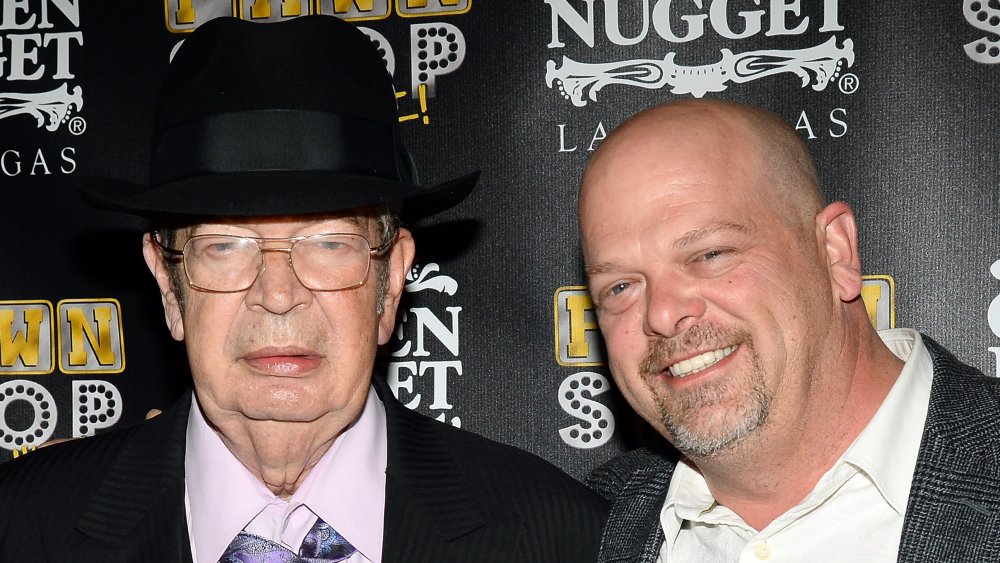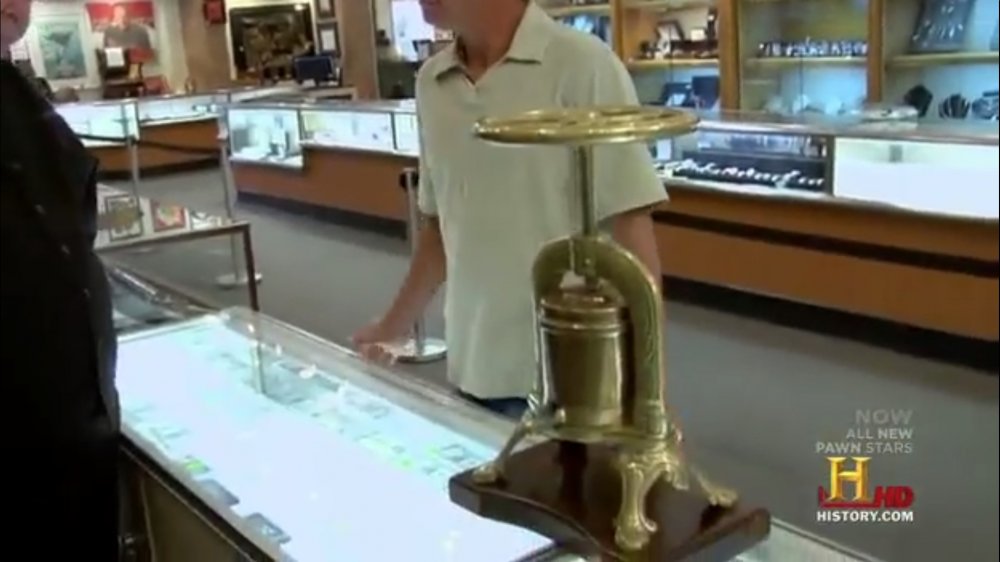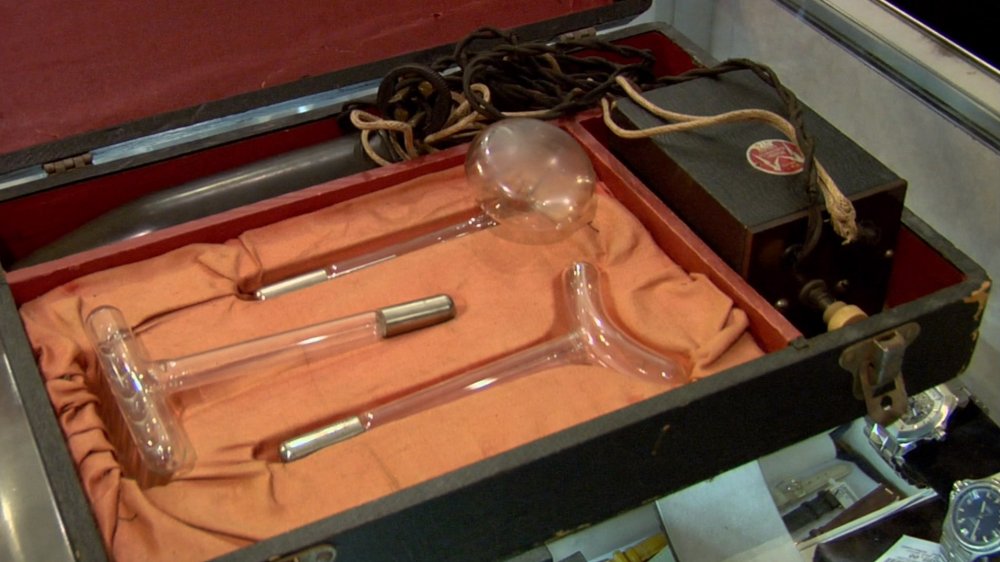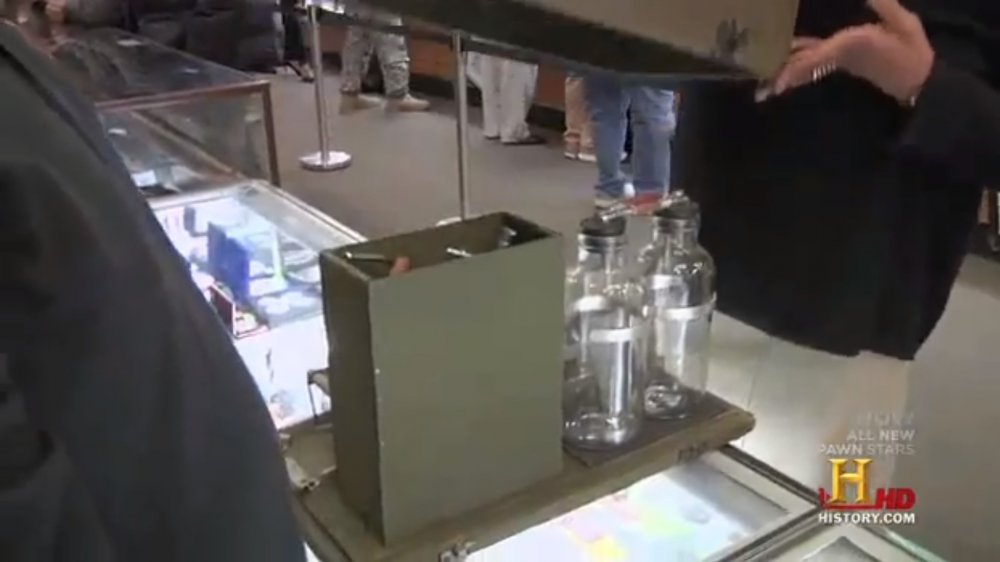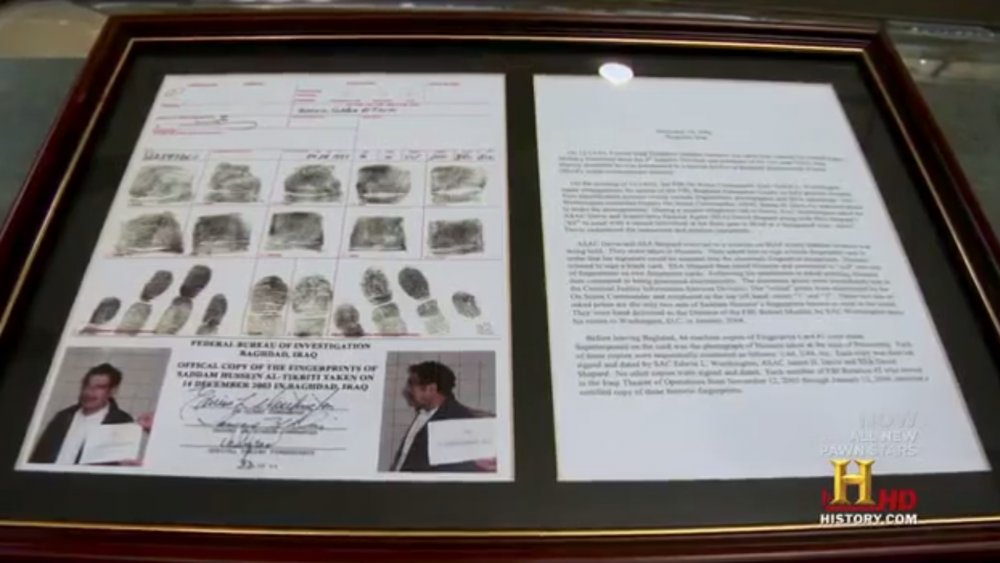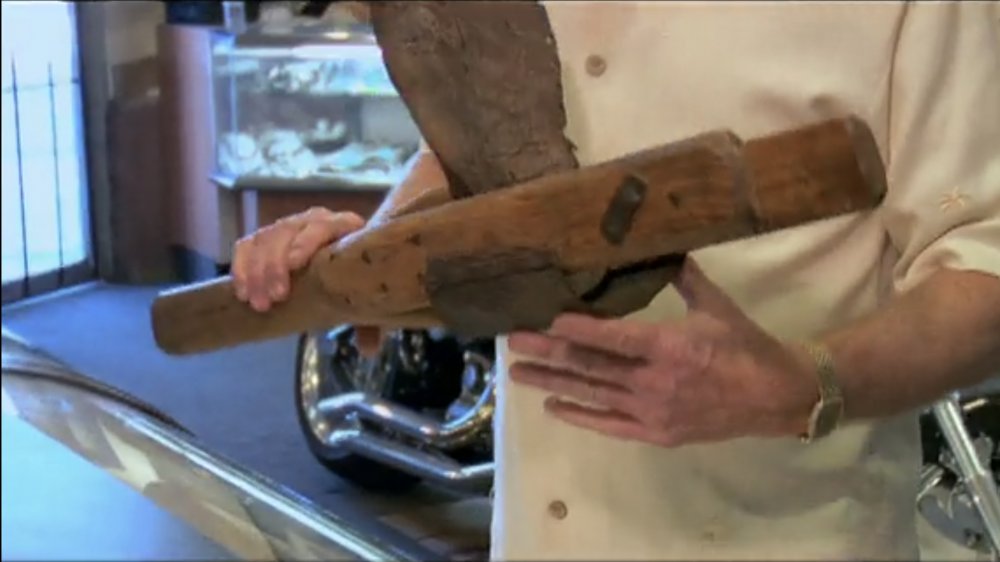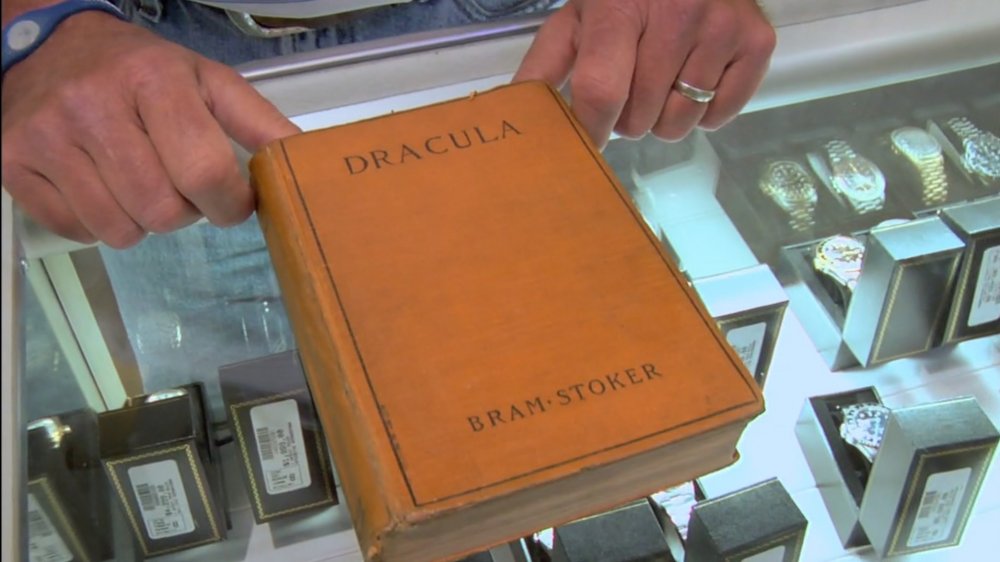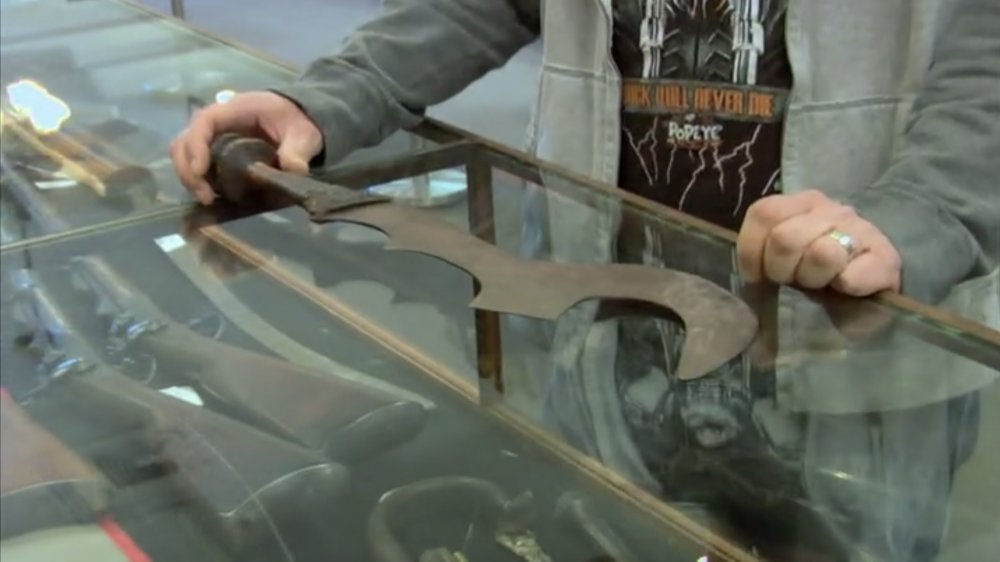The Creepiest Historical Items Seen On Pawn Stars
If there's one thing television networks have learned from the reality show era, the public absolutely loves programs where experts tell regular people what the weird stuff they found in the attic is worth. There's a million variations of shows like this and, honestly, they don't really get boring because people always find new and unusual things to bring forward.
One of the most popular of these shows is Pawn Stars, a History Channel show where the Harrison family, owners of the World Famous Gold & Silver Pawn Shop in Las Vegas, and their friends evaluate, and often buy, various items from any old stranger who walks in. Typically, these are your normal things, like musical instruments, antiques, vintage toys, and so on.
But very occasionally, a customer brings in something truly strange. Old medical tools, bizarre items owned by historical figures, and even brutal ancient weapons. Sometimes, the things that pop up on the show are downright terrifying.
A real Egyptian mummy mask
Mummy curses are a staple of horror pop culture. Don't mess with a mummy or their stuff. You will regret it. But mummy stuff also happens to be quite valuable, since it's fairly rare and only a limited amount of it exists. So, do you risk a mummy curse for the chance at some good old-fashioned, hopefully not-cursed cash?
In the season 13 episode "Silver Stash Pawn," a customer named Jad brings in something the shop has never seen before: A cartonnage (something like papier-mâché, used by Ancient Egyptians) mummy mask from the second century BCE. This would have been placed on top of the mummy's face as a sort of identifier. Jad doesn't say how he got his hands on it, but he does ominously mention he has some knowledge in the field.
Corey decides to call in an expert, Dr. Phineas Kastle, who looks like he stepped right out of a Rudyard Kipling book. Kastle does confirm the mask is real, and it's worth about $20,000. Jad's initial asking price was $70,000, but he comes down to $30,000 with this new information. That's a bit high for the shop, so Corey nearly lets him walk away, but changes his mind at the last moment and agrees to buy it for $30,000. Here's hoping it's not cursed after all.
A horrifying vintage tonsil remover
It's not terribly uncommon to meet someone who had their tonsils out as a kid. It's a fairly regular occurrence in this day and age, and the surgery required isn't anything too complicated. It's actually pretty routine. But what about the days before modern medicine? As you can imagine, without anesthetic and precise surgical tools, things got pretty scary.
Enter the tonsillotome, invented in 1827 by Philip Physick. Brought into the shop in the season eight premiere, "Rick 'n' Roll," by Dr. Daliah Wachs, the tonsillotome is a long device that basically acts like a tiny guillotine for the tonsils, making it simple to reach down to the back of the patient's throat and snip them off. One problem, though: They didn't remove the most dangerous part of the tonsils, so their effectiveness was pretty questionable. There's a reason why these things aren't used today. Since they were used without anesthesia, you can probably imagine the pain involved, and that's not to mention all the blood from such a brutal excision.
Dr. Daliah initially asks for $1,100. Corey counters with $500. Corey notes doctors who would find the tonsillotome interesting likely have money and would be willing to pay for it. Dr. Daliah counters that an ear, nose, and throat specialist would pay even more, so Corey agrees to raise the price, and after some further haggling, they agree on an $800 sale.
The creepiest toy chimpanzee ever
Ever seen a horror movie with one of those creepy monkeys with tiny cymbals it claps together? Turns out, those are based on real-life, terrifying toys. You might even remember the one from Toy Story 3, a creature with bulging red eyes. That's an actual toy, called the Musical Jolly Chimp. And no, it doesn't look very jolly, but maybe they thought putting "Noisy Bloodthirsty Chimp" on the box wouldn't get as many sales.
In season 3, episode 15, "Monkey Business," a woman named Dana brings her Musical Jolly Chimp into the shop. Manufactured by Daishin, a Japanese toy company, in the 1950s, the chimps are the definition of vintage toys, and Dana's is in very good condition. It's even in the original box. In fact, the only reason she wants to get rid of it is because her grandchildren are terrified of it. That's very relatable, and a completely understandable reason to want to get it out of your house.
The Old Man looks it over and, knowing the profit old toys in good shape can bring, does something almost unheard of on the show. Dana only asks $100 for the nightmare chimp, and the Old Man actually goes up and offers her $150 instead, saying he could easily get $300 for it and not feeling comfortable purchasing it for only $100.
An antique French duck press
While French cuisine is highly regarded worldwide, and French chefs are some of the best out there, it can stray into weird territory, like foie gras, where a duck or goose liver is expanded by force-feeding the animal until it's close to bursting, then slaughtering it and serving the liver, sometimes raw. Basically, French cuisine is really strange about waterfowl.
In season five, episode six, "Silence of the Lambo," a customer named Keith brings in something that looks like a brass bell with a crank wheel on top. Keith tells the Old Man and Chumlee it's a duck press. Neither of them knows what that is, so Keith explains. In French cuisine, the duck press is used to crush a roasted duck carcass until a sauce made of blood and fat drips out of a tiny spout. This is done tableside, so the duck press is very ornate, and you get to see the duck goop come right out. Delicious!
Keith asks $9,000 for the press, but the Old Man says it's too much and offers $1,500. Keith requests $3,000 instead, stating in his research he found one that sold for $11,000, but the Old Man thinks it would take a very long time to sell, if it ever sells at all. In the end, Keith and the shop can't agree on a sale price, so Keith leaves with his fancy duck squisher.
A working electroshock therapy kit
We've all heard the stories of the days of quack medicine, before the FDA regulated drugs and medical devices. Bizarre concoctions that probably made you sick instead of curing anything, miracle cure devices that were of questionable efficacy, and procedures that were unnecessary at best and downright deadly at worst.
One of the most common forms of quackery came in the form of electrical "cures." Basically, the early 20th century was so obsessed with electricity they just assumed it could fix anything. While the most extreme forms of this came in electroconvulsive therapy, there were plenty of gadgets that claimed they could work miracles using the power of electricity, like restoring hair, removing acne, or even soothing minor aches and pains.
In season four, episode 27, "Weird Science," a woman named Maureen brings one of these consumer-level devices into the shop, called the Master Violet Ray no. 11, that still actually works. After playing around and shocking one another with it, Rick and Chumlee get down to business. Maureen wants $100, and Rick counters with $75, which she accepts. Since it's not all that dangerous, there's no chance for legal or liability issues, but it's a creepy reminder of the days not all that long ago where people could make up any old humbug and sell it to regular people without oversight.
A turn-of-the-century blood transfusion kit
Blood transfusions now are highly regulated. Only blood stored properly and screened for any diseases or pathogens can be used. But we got to this point by centuries of, well, not doing that. Refrigeration didn't exist before the 20th century, so if you tried to store blood, it would likely coagulate and become useless very quickly. And screening for any potential illnesses that might come from the blood? Forget about it. Even matching up blood types is a relatively recent phenomenon, as blood types were only discovered in 1900.
So what did doctors do before all of those things? Well, they had to use fresh blood, for one thing, even their own if it came down to it. And then they performed the transfusion with a barbaric-looking blood transfusion kit, just like the kind brought in by a customer named Artie in season five, episode 25, "Pawnocchio."
Made by the C.M. Sorensen Company, it's basically just some tubing and two large glass bottles, with the actual pumping being done manually by using a foot pump. Artie describes it as being for "lazy vampires." Not exactly state-of-the-art medical tech. Artie wants $211 for it, which is an oddly specific number, but she claims it "gives you room to negotiate." Chumlee offers her $100, but Artie successfully gives Chumlee the stink-eye and convinces him to go up to $125. Hopefully whoever buys it never actually needs it.
Saddam Hussein's fingerprints
In 2003, former dictator Saddam Hussein, who ruled Iraq from 1979 until he was overthrown, disappeared. Fearing a situation like Osama bin-Laden, who went into hiding for several years after the events of September 11, 2001, the American people assumed Hussein would likely never turn up and rumors of his status would continue on. But amazingly, in December 2003, U.S. forces found Hussein hiding in a spider-hole near a farmhouse in ad-Dawr. Looking far more disheveled than his typical appearance, American soldiers took custody of Saddam.
During his arrest, Hussein was fingerprinted by the FBI. That's where Bill comes in. A former FBI agent, Bill was in Iraq when Saddam was captured. While the original documents are kept in the bureau's vaults, the FBI gave certified copies of the fingerprints to all agents who were involved in the capture. So, Bill brought his certified copy of Saddam Hussein's fingerprints into the shop in season five, episode six, "Silence of the Lambo."
While Rick mentions he has a policy against buying items related to "bad guys," he's interested in buying Bill's copy. Bill asks for $10,000, but Rick isn't able to go that high. He offers $1,500 instead, but Bill decides not to take the offer and leaves, taking his strange piece of military history with him.
A real (used) peg leg
Before the days of fancy prosthetics and stuff that not only resembles actual lost body parts, but are now in some cases even better than what was there before, people either had to just make do with lost limbs or make a replacement out of whatever they had. Thus, wooden peg legs came to exist.
Peg legs are typically associated with pirates on the high seas, and that's probably what immediately popped into your head. That's what a customer named Charlie thought, too, when he brought one to the shop in season two, episode 17, "Bow Legged." But, as the handy trivia text points out, artificial limbs have been in use since Ancient Egypt, so it's possible it could be from many different points in time. Rick suspects the leg actually hails from a different era: the Civil War.
So Rick calls in Rod, an expert in nautical antiques, who agrees it is a Civil War artifact based on the hardware used, as there are manufactured nails with flat heads, something that wouldn't have existed before the mid-1800s. Rod estimates it's worth about $1,000. He also points out there is indeed evidence it really was used, so this thing wasn't just for show. Charlie had initially wanted $7,500 when he believed it belonged to a pirate, but Rick can only offer $500 with the new information. Charlie decides not to go forward and walks out with three legs.
A copy of Dracula signed by Bram Stoker
One of the original horror novels that has spawned endless movies, theatrical adaptations, video games, and so on, Dracula tells the story of, well, Dracula, an ageless vampire who arrives in London and torments the people he encounters there. To say it's an influential story is a huge understatement. Dracula forms one of the pillars upon which horror stories are based to this day, and Dracula as a character is a massive figure, even appearing in scores of things that aren't directly based on the novel.
So you can imagine Big Hoss's excitement in season four, episode 31, "High Stakes," when a customer named Mark brings in not only a hardcover copy of the novel from the original United States pressing, but one that is autographed by author Bram Stoker himself. It even includes a date, also written by Stoker, of September 16, 1897, the year the novel was released. Big Hoss points out it's not a first edition, since the book was originally published in Europe and not the U.S., which would have made it even more valuable, but it's still worth some money.
Mark wants $15,000, but has no paperwork authenticating it, so Big Hoss invites a forensic document examiner named Drew to take a look. Drew confirms it is authentic and estimates it's worth about $5,000. Big Hoss offers $2,000, and he and Mark eventually settle on $2,350.
A Congolese beheading sword
Throughout history, there have been an uncountable number of different civilizations, and they all used tools and weapons of various shapes and sizes. It can be difficult to tell just where a piece came from, something the people on Pawn Stars often encounter, which requires calling in an expert. But sometimes it can even be unclear just what an item is in the first place.
This was the situation faced by Rick when a customer named Ryan brought in a hand-held blade with multiple curves in season four, episode 25, "Silent and Deadly," making it look something like a cross between a weapon and a scythe for harvesting. Ryan wasn't sure, as it was given to him by an uncle who had passed on, and Rick and Chumlee had no idea either. The blade was made from iron, but crudely forged, indicating whoever made it had good materials, but maybe not advanced blademaking skills seen in other cultures.
Rick calls in a friend, Sean, who is an expert in antique weapons and armor. He determines it's a sword used by tribes in the Congo from the mid-1800s, and it would have been wielded by a chieftain specifically for the purpose of beheading enemies. Yikes. Sean estimates it's worth about $400, and after some haggling, Rick and Ryan agree on a sale price of $225, no decapitations required, thankfully.
A nuclear bomb cover
While they deal with a great many dangerous weapons on Pawn Stars, from guns and swords to more unusual weaponry, nothing beats the piece brought in by Brian in season 10, episode four, "Put Up Your Nukes." What appears to be some sort of red warning cone is, according to Brian, the cover from a thermonuclear warhead, one of the deadliest weapons in the history of humanity.
Thermonuclear weapons, similar to nuclear weapons, cause massive amounts of destruction through atomic fusion, creating those enormous mushroom clouds you've seen in documentaries for decades. Thermonuclear weapons, also known as hydrogen bombs, are a higher yield and size from standard nuclear warheads, as the trivia text points out. What Brian has is a component to one of the most horrific weapons of war ever devised.
The cover, which comes from an American B-57 warhead according to a small plate attached to the side, is a bit out of Rick's expertise, so he visits with an expert, Allan, from the nearby National Atomic Testing Museum (it is Vegas, after all). Allan says the cover isn't from a hydrogen bomb, but a regular nuclear bomb instead, and was used to protect the bomb's nose cone to prevent accidental explosions. Allan has a defused B-57 right in the museum, so Rick and Brian try it on, finding it's a perfect fit. Brian wants $800 for it, and after a little back and forth, Rick buys it for $625.
A World War I surgeon's kit
The first World War, waged from 1914-1918, was one of the bloodiest conflicts to happen in human history, but is especially disturbing because by then humans had photographic and even some video footage that could directly show the horrors of war. Since it was also the first major war after the invention of many modern medical and surgical techniques, it also showed people some of the unsettling things a combat medic or nurse might have to deal with on the battlefield. Surgery is fraught enough as it is, so imagine performing it in a trench with no real facilities, bullets and bombs flying overhead, and dirt and disease all around you.
Bob, a customer that visited the shop in season 15's premiere, "Going, Going... Pawn!" had just the historical piece to demonstrate this: a World War I German field surgery kit. Rick and Big Hoss open it up to find brutal surgical instruments that were a necessity at the time, and Rick even points out a particular device, which looks sort of like a pair of pruning shears, was likely used to amputate fingers.
Bob wants $10,000 for it, and the kit is in great shape and complete, but Rick mentions there aren't a lot of collectors out there for this kind of item, so he offers Bob $2,000. They end up at $2,800, and Bob agrees, selling this creepy piece of medical and military history to the shop.
